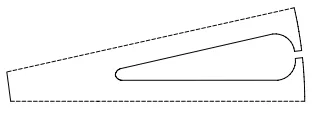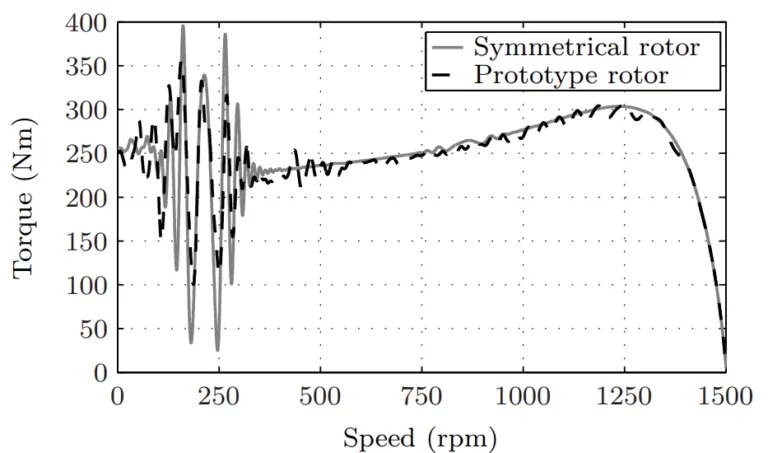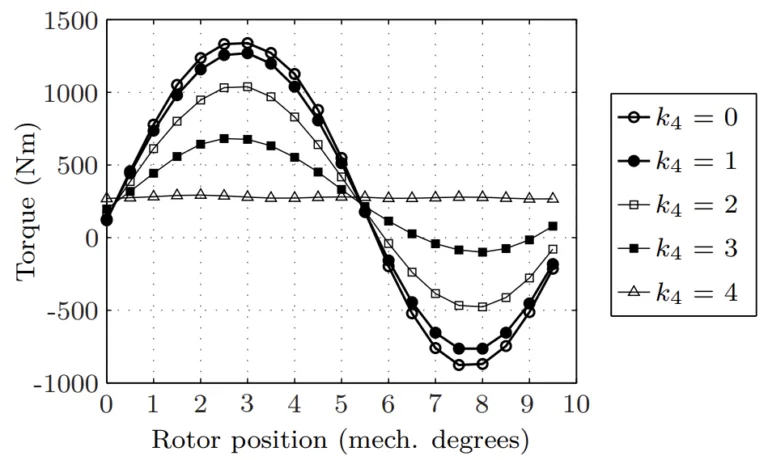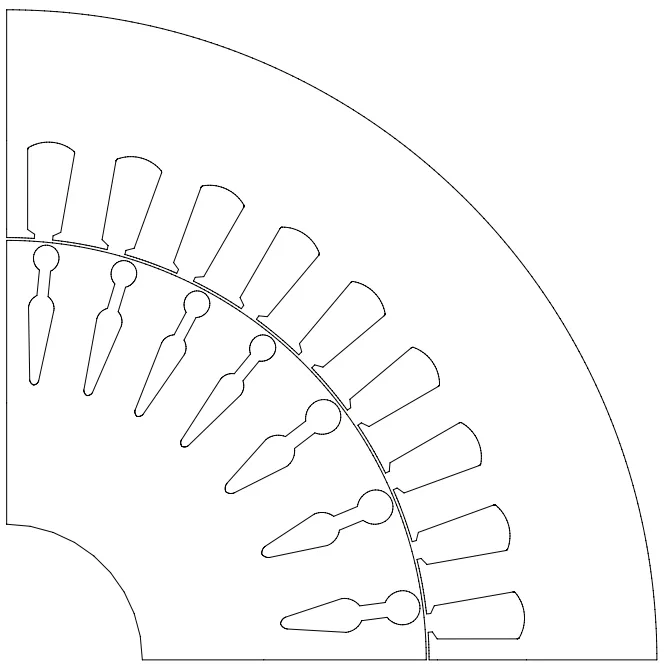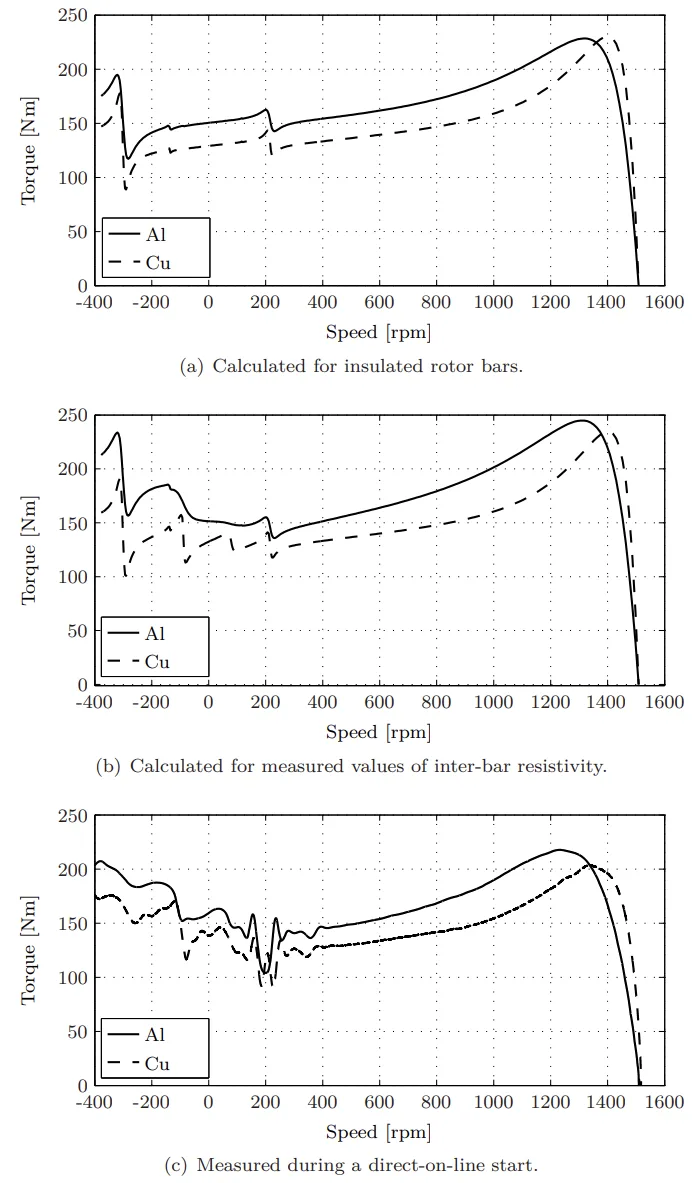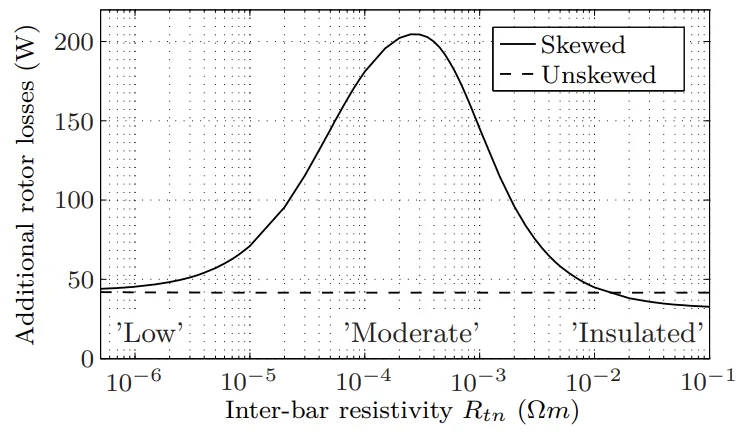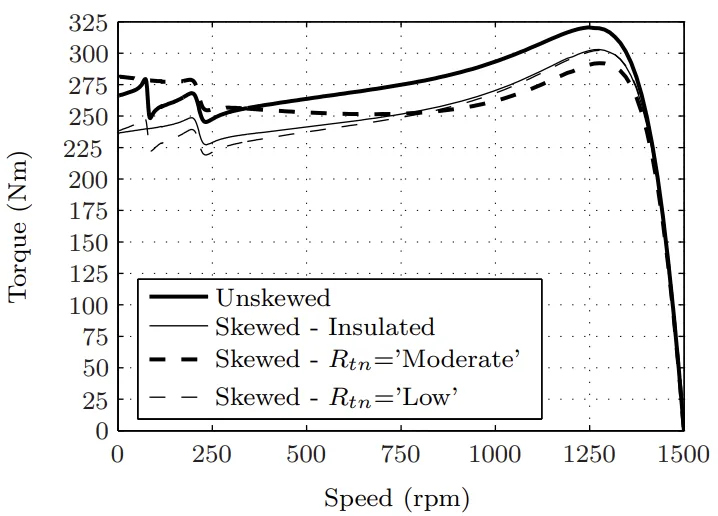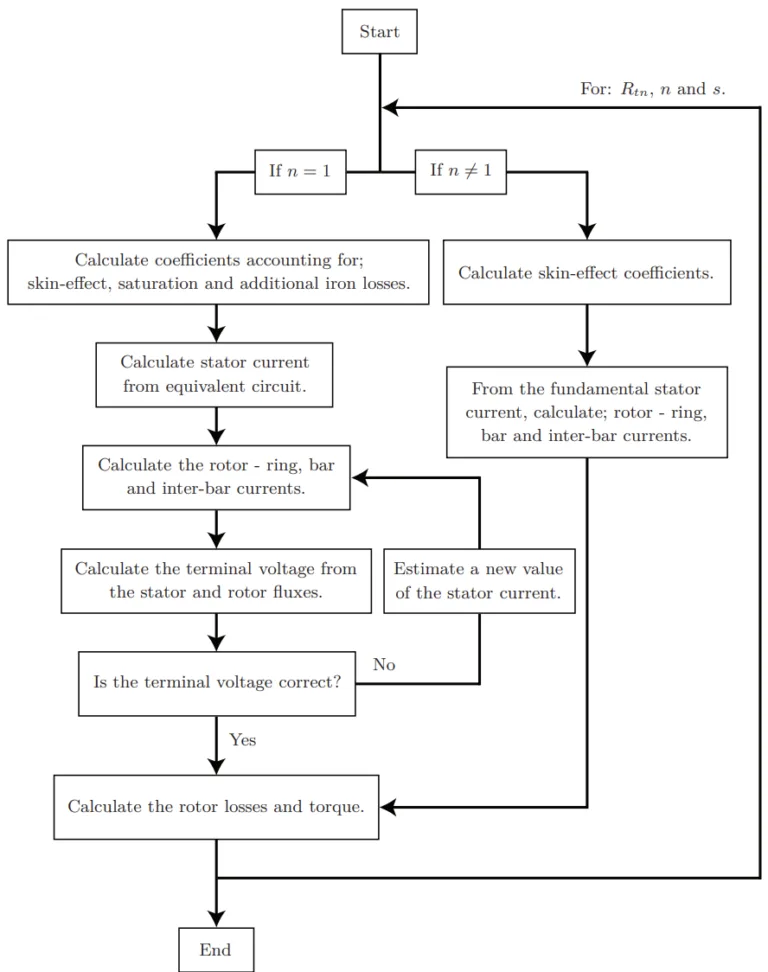本紹介資料は、「KTH Royal Institute of Technology」より発行された博士論文「Analysis and Reduction of Parasitic Effects in Induction Motors With Die-Cast Rotors」に基づいています。

1. 概要:
- タイトル: Analysis and Reduction of Parasitic Effects in Induction Motors With Die-Cast Rotors (ダイカスト回転子を持つ誘導電動機における寄生効果の解析と低減)
- 著者: ALEXANDER STENING
- 発行年: 2013
- 発行学術誌/学会: KTH Royal Institute of Technology
- キーワード: Aluminium rotors (アルミニウム回転子), asynchronous torques (非同期トルク), copper rotors (銅回転子), die-cast rotors (ダイカスト回転子), induction machines (誘導機), inter-bar currents (バー間電流), modulated rotors (変調回転子), starting torque (始動トルク), stray losses (漂遊負荷損), synchronous torques (同期トルク).
2. 抄録:
本論文は、ダイカストアルミニウムおよびダイカスト銅回転子を持つ誘導電動機におけるバー間電流効果に関する研究を提示する。これらの電流によって引き起こされる寄生効果を解析し、これらの問題に対する可能な解決策を提示する。これは、バー間電流効果のシミュレーションのための解析ツールを開発することによって実現される。使用された手法は、試作機での測定によって検証される。バー間電流は、モータの始動性能にかなりの影響を与え、それがプルアウトトルクの減少につながる可能性があることが示される。定格運転時には、これは高調波回転子電流の増加として見られ、モータ性能に悪影響を与える。
熱量測定の結果から、スキュー付きダイカストアルミニウム回転子をスキュー付きダイカスト銅回転子に置き換えた場合に得られる効率向上は、理論的な期待値よりも低いことが示される。これは、銅回転子の力率が低下した結果であることが示される。高いバー間電流がこの効果の原因であると考えられており、回転子起磁力の高調波成分を増加させる。これは、回転子漏れリアクタンスの増加として現れるであろう。固定子拘束試験の結果、および測定されたバー間抵抗値を用いたシミュレーションが、この理論を裏付けている。
これらの悪影響は、スキューなし回転子の使用によって無視できるレベルまで抑制されるが、低速での大きな同期トルクという代償を伴うことが示される。非対称な回転子スロット分布を持つ変調回転子の概念を用いることにより、この寄生トルクを低減するためにスキューなし回転子が設計される。試作機での測定により、変調回転子はバー間電流と同期トルクの両方を抑制し、モータ効率の有意な変化なしに始動性能を向上させることが示される。提示された結果は、変調回転子の概念の可能性を強化し、誘導機に現れる悪影響を低減するための新たな可能性を導入するものである。
3. 緒言:
誘導機は最も一般的に使用される電気機械であり、その効率を改善することはエネルギー保全にとって極めて重要である。損失の低減には、よく知られた固定子および回転子の銅損、鉄損、摩擦損だけでなく、追加損失(定格負荷では漂遊負荷損と呼ばれる)の低減も含まれる。これらの損失は通常、モータ入力電力の0.5%~3%の範囲であるが、それ以上になることもある[1, 2, 3]。中小規模の誘導電動機は、しばしば費用対効果の高いダイカストアルミニウム回転子を使用する。鋳造技術の進歩により、ダイカスト銅回転子の製造も可能になり、銅の高い導電率は回転子かご損失を低減する(約40%のI2R損失削減が報告されている[4])。銅を活用するように機械を再設計すれば、効率をさらに向上させることができる[5, 6, 7, 8]。
回転子スキューは、騒音低減[9]および(バーが絶縁されている場合)非同期トルクと高調波損失の抑制[10]のための一般的な慣行である。しかし、ダイカスト回転子はスロット絶縁が欠如しているため、スキュー設計では望ましくないバー間電流が発生する。これらの電流は、始動時の非同期トルクを増加させ[11]、漂遊負荷損を増加させる可能性があり[12, 13]、その大部分を占める可能性がある[3]。
産業界の経験では、ダイカストアルミニウム回転子をダイカスト銅回転子に置き換えた場合、理論的に期待されるほどの効率向上が得られないことが示唆されていた。この不一致は、バー間電流の影響であると疑われた。バー間電流はバー間抵抗に強く影響され、この抵抗はかご材料とダイカストプロセスに依存する可能性が高いため、アルミニウムと銅の回転子の概念間に違いがあることを示唆している。
4. 研究概要:
研究テーマの背景:
ダイカスト回転子は誘導電動機で広く使用されている。銅回転子はアルミニウムよりも高い導電性を提供し、潜在的に効率を向上させるが、特に一般的な技術である回転子スキューと共に実装されると、寄生効果を引き起こす。ダイカスト回転子の絶縁不足は、スキュー時にバー間電流を許容し、性能(トルク特性、損失)に悪影響を与える。これらの効果、特にアルミニウムと銅のダイカスト回転子間の違いを理解し、軽減することは、高効率モータの設計に不可欠である。
先行研究の状況:
先行研究では、ダイカスト銅回転子の損失低減の可能性[4, 5, 6, 7, 8]と、スキュー回転子におけるバー間電流の悪影響[11, 12, 13]が確認されていた。バー間抵抗の測定方法も存在した[14, 15, 16]。しかし、ダイカストアルミニウム回転子と銅回転子間のバー間電流効果の直接比較、および銅で観察された期待以下の効率向上の説明には、さらなる調査が必要であった。スキューなし設計の問題に対処するための変調回転子の概念が提案されていたが[31]、始動性能と損失に関する評価が必要であった。
研究目的:
主な目的は、ダイカストアルミニウム回転子とダイカスト銅回転子の両方におけるバー間電流の影響を評価し、理論的な期待値と比較して銅回転子で観察された効率低下がこれらの効果によるものかどうかを判断し、特定された寄生効果(プルアウトトルクの低下や同期トルクの増加など)を軽減するための解決策を提案し検証することであった。
中核研究:
本研究は、アルミニウム回転子と銅回転子のバー間抵抗測定を含み、銅の方が著しく低い抵抗を示すことを明らかにした。飽和と表皮効果を組み込んで、バー間電流効果をシミュレーションするための解析モデルが開発された。スキュー付きアルミニウム回転子と銅回転子に関する比較研究(11kWおよび15kW機でのシミュレーションと実験)が実施された。これらの結果、銅回転子はより低いプルアウトトルクと低下した力率を示し、期待以下の効率向上につながることが示された。これは、低いバー間抵抗による高い高調波回転子電流が漏れインダクタンスを増加させるためと考えられた。また、スキューなし回転子を調査し、バー間電流の抑制を確認したが、大きな同期トルクの問題を浮き彫りにした。これを解決するために、非対称スロット分布を持つスキューなし「変調回転子」の概念が設計、シミュレーション、テストされた。この試作品は、定格効率に大きな影響を与えることなく、バー間電流と同期トルクの両方を首尾よく低減し、改善された始動性能をもたらした。
5. 研究方法論
研究設計:
本研究は、解析モデリング、数値シミュレーション(FEMを含む)、および実験的検証の組み合わせを採用した。スキュー付きアルミニウム、スキュー付き銅、スキューなし対称アルミニウム、および新しいスキューなし変調(非対称)アルミニウム回転子という、異なるダイカスト回転子タイプを搭載した誘導電動機の性能を比較した。2つの主要なモータフレームが使用された:Al/Cu比較用の11kW機と、スキュー効果および変調回転子概念評価用の15kW機。
データ収集および分析方法:
- バー間抵抗測定: Odok [14] および Dabala [15, 16] の手法に基づき、バー間抵抗を測定するための専用テストリグ (Fig. 2.1) が開発された。
- 解析モデリング: Behdashtiの研究 [17, 11] から派生した解析モデルを使用して、バー間電流とそのモータ性能への影響 (Fig. 2.2) を計算した。このモデルは、MMF空間高調波、固定子スロットによる空隙パーミアンス変動、回転子バーの表皮効果 [18]、および漏れ経路の飽和(FEM/固定子拘束試験から導出)を考慮した。
- 実験テスト:
- トルク-速度特性測定のための直接オンライン始動テスト (Fig. 3.1, 4.8, 4.9)。
- 総損失および漂遊負荷損の正確な測定のための熱量測定 (Table 3.2, Fig. 3.3)、IEC 60034-2-1 [27] に従った損失分離を含む。
- 効率および力率決定のための定格および部分負荷テスト (Fig. 3.4, Table 3.3, Table 3.4, Table 4.1)。
- 固定子拘束試験 (Locked-rotor tests)。
- シミュレーション: FEMシミュレーションを使用して、漏れ経路飽和係数を検証し、変調回転子性能(例:固定子拘束トルク変動 Fig. 4.4、始動トルク Fig. 4.7)を解析した。変調設計のために回転子パーミアンスにフーリエ解析を適用した (Fig. 4.3, 4.5)。
研究テーマと範囲:
研究は以下に焦点を当てた:
- ダイカストアルミニウムおよび銅回転子におけるバー間抵抗の定量化。
- バー間電流が以下に与える影響の解析:
- 始動性能(プルアウトトルク、非同期トルク、同期トルク)。
- 定格性能(効率、力率、漂遊負荷損、高調波回転子電流)。
- スキュー付きアルミニウム回転子とスキュー付き銅回転子間の性能差の比較。
- スキューなし回転子使用のトレードオフ評価(バー間電流低減 vs. 同期トルク増加)。
- 許容可能な性能を維持しつつ、スキューなし回転子における同期トルクを低減する方法としての「変調回転子」概念(特にProgressive Sinusoidal変調)の開発と評価。
- 研究は主に4極、11kW(軸高さ132mm、36固定子/28回転子スロット)および15kW(軸高さ160mm、36固定子/28回転子スロット)誘導電動機に基づいていた。
6. 主要な結果:
主要な結果:
- 測定により、研究対象のダイカスト銅回転子のバー間抵抗率は、研究対象のダイカストアルミニウム回転子よりも少なくとも10倍低いことが示された (Table 3.1)。
- シミュレーションと測定により、スキュー付き銅回転子のプルアウトトルクは、同等のスキュー付きアルミニウム回転子よりも低いことが確認された (Fig. 3.1)。
- 11kW機での熱量測定により、スキュー付きアルミニウム回転子をスキュー付き銅回転子に置き換えた場合に得られる効率向上(0.6パーセントポイント)は、理論的な期待値(1.1パーセントポイント)よりも低いことが示された。これは、銅回転子の力率低下に起因するとされた (Fig. 3.4, Table 3.3)。
- 銅回転子の力率低下は、低いバー間抵抗率による高い高調波回転子電流が、回転子MMFの高調波成分を増加させ、それによって回転子漏れリアクタンスを増加させることによって引き起こされると考えられている。固定子拘束試験がこれを裏付けている。
- 11kW機では、スキュー付きAl回転子とスキュー付きCu回転子の漂遊負荷損は同程度であり、銅を使用した場合、これらの損失が減少するのではなく再配分されることを示唆している (Fig 3.3)。
- 回転子スキューを除去すると、有意なバー間電流はなくなるが、大きな同期トルクが発生し、始動に失敗する可能性がある (Fig 2.3, Fig 4.8)。
- 新しいスキューなし変調回転子設計(非対称スロット分布)が開発され、15kW機でテストされた。
- 試作変調回転子の測定により、対称的なスキューなし回転子と比較して同期トルクを首尾よく抑制し (Fig 4.8, Fig 4.9)、結果として始動性能が向上したことが示された。
- 変調回転子は、標準的なスキュー付き回転子と比較して、定格モータ効率の有意な変化なしにこの改善を達成した (Table 4.1)。
図の名称リスト (Figure Name List):
- Figure 1.1: Slot shape for the rotors used in the 11 kW machine.
- Figure 1.2: Slot shape for the rotors used in the 15 kW machine.
- Figure 2.1: Rotor test setup for measurements of inter-bar resistance.
- Figure 2.2: Procedure for the calculation of motor performance at different slip and inter-bar resistivity.
- Figure 2.3: Starting torque for the 15 kW machine at different inter-bar resistivities Rtn.
- Figure 2.4: Additional rotor losses for the 15 kW machine at rated power as a function of inter-bar resistivity.
- Figure 3.1: Starting torque at rated voltage for the studied aluminium and copper rotors skewed by one stator slot pitch.
- Figure 3.2: Additional rotor cage losses simulated as a function of inter-bar resistivity for the skewed rotors at the rated shaft power of 11 kW.
- Figure 3.3: Residual losses as a function of normalized torque squared.
- Figure 3.4: Efficiency (a) and power factor (b) as a function of normalized shaft power.
- Figure 4.1: One quarter of a Dual 24:32 machine having 28 rotor slots and pole symmetry.
- Figure 4.2: One quarter of a PS-rotor having 36 rotor slots and pole symmetry.
- Figure 4.3: Dominating slot numbers for the 36 slot rotor, without PS modulation (black) and with PS modulation (grey).
- Figure 4.4: Locked rotor torque as a function of the rotor position for the 36 slot rotor at different levels of PS modulation.
- Figure 4.5: Dominating slot numbers included in the rotor permeance for the modulated prototype rotor.
- Figure 4.6: One quarter of the modulated prototype rotor, having pole symmetry.
- Figure 4.7: FEM-simulated starting torques for the two unskewed rotors.
- Figure 4.8: Measured torque as a function of speed for the different rotors tested in the same 15 kW stator.
- Figure 4.9: Measured torque during deceleration from no-load to stand-still for the three rotors tested in the same stator.
7. 結論:
本研究は、ダイカスト銅回転子のバー間抵抗率がアルミニウム回転子よりも著しく低いことを実証した。これは、スキュー付き銅回転子においてより高いバー間電流を引き起こし、シミュレーションと測定によって検証されたように、同等のアルミニウム回転子と比較してより低いプルアウトトルクをもたらす。熱量測定試験により、スキュー付き銅をスキュー付きアルミニウムの代わりに使用することによる効率向上は、理論的な期待値よりも低いことが明らかになった。この性能低下は、銅回転子の力率低下に関連しており、これは低いバー間抵抗によって増幅された高調波電流による回転子漏れリアクタンスの増加が原因である可能性が高い。
15kWアルミニウム回転子の調査では、スキューを除去するとプルアウトトルクが11%減少することが示された。シミュレーションによれば、スキュー漏れは5%しか占めておらず、スキュー付き回転子のバー間電流が有意な制動トルクを生成したことを示唆している。スキューなし回転子はわずかに高い効率を提供したが、大きな同期トルクに悩まされた。
これらの問題に対処するために、非対称スロットを持つスキューなし変調回転子が設計され、テストされた。この試作品は、(スキューがないことによる)バー間電流と(変調による)同期トルクの両方を首尾よく低減し、始動性能の向上につながった。重要なことに、これは、いくつかの製造上の不完全さにもかかわらず、標準的なスキュー付き回転子と比較してモータ効率の有意な変化なしに達成された。これらの発見は、誘導機における寄生効果を軽減するための柔軟な解決策としての変調回転子の概念の可能性を確認するものである。
8. 参考文献:
- [1] A.R. Hagen, A. Binder, M. Aoulkadi, T. Knopik, and K. Bradley. Comparison of measured and analytically calculated stray load losses in standard cage induction machines. Proc. of International Conference on Electrical Machines, pages 1–6, 2008.
- [2] A.A. Jimoh, R.D. Findlay, and M. Poloujadoff. Stray losses in induction machines: Part i, definition, origin and measurement. IEEE Trans. on Power Apparatus and Systems, PAS-104:1500–1505, 1985.
- [3] H. Nishizawa, K. Itomi, S. Hibino, and F. Ishibashi. Study on reliable reduction of stray load losses in three-phase induction motor for mass production. IEEE Trans. on Energy Conversion, EC-2:489–495, 1987.
- [4] D. T. Peters, D. J. Van Son, J. G. Cowi, and E. F. Brush. Improved motor energy efficiency and performance through the die-cast copper rotor. In Proc. of International Conference on Electrical Machines, Aug. 2002.
- [5] S. Lie and C. Di Pietro. Copper die-cast rotor efficiency improvement and economic consideration. IEEE Trans. on Energy Conversion, 10(3):419–424, Sep 1995.
- [6] R. Kimmich, M. Doppelbauer, D. T. Peters, J. G. Cowi, and E. F. Brush. Die-cast copper rotor motors via simple substitution and motor redesign for copper. In Proc. of International Conference on Electrical Machines, Sept. 2006.
- [7] J. L. Kirtley, J. G. Cowie, E. F. Brush, D. T. Peters, and R. Kimmich. Improving induction motor efficiency with die-cast copper rotor cages. In Proc. of IEEE PES General Meeting, pages 1–6, June 2007.
- [8] D. T. Peters, E. F. Jr Brush, and J. L. Kirtley. Die-cast copper rotors as strategy for improving induction motor efficiency. In Proc. of Electrical Insulation Conference and Electrical Manufacturing, pages 322–327, Oct. 2007.
- [9] P. Vijayraghavan and R. Krishnan. Noise in electric machines: a review. IEEE Trans. on Industry Applications, 35(5):1007–1013, sep/oct 1999.
- [10] P. L. Alger. Induction Machines: Their Behavior and Uses. Taylor & Francis, 1995.
- [11] A. Behdashti and M. Poloujadoff. A new method for the study of inter-bar currents in polyphase squirrel-cage induction motors. IEEE Trans. on Power Apparatus and Systems, PAS-98(3):902–911, 1979.
- [12] Y.N. Feng, J. Apsley, S. Williamson, A.C. Smith, and D.M. Ionel. Reduced losses in die-cast machines with insulated rotors. IEEE Trans. on Industry Applications, 46(3):928–936, May-June 2010.
- [13] S. C. Englebretson. Induction machine stray loss from inter-bar currents. Ph.d. thesis, Massachusetts Institute of Technology, Sept. 2009.
- [14] A. M. Odok. Stray-load losses and stray torques in induction machines. AIEE Trans. on Power Apparatus and Systems, 77(3):43–53, 1958.
- [15] K. Dabala. A new experimental-computational method to determine rotor bar-iron resistance. Proc. of International Conference on Electrical Machines, 2:69–72, 1996.
- [16] K. Dabala. Modified method to determine rotor bar-iron resistance in three-phase copper casted squirrel-cage induction motors. Proc. of International Conference on Electrical Machines, pages 231–234, 2006.
- [17] A. Behdashti. Contribution a l’etude des pertes supplementaires des machines asynchrones dans une tres large zone de fonctionnement. PhD thesis, L’Institut national polytechnique de Grenoble, June 1975.
- [18] C. Sadarangani. Electrical machines - design and analysis of induction and permanent magnet motors. KTH Hogskoletryckeriet, 2000.
- [19] A. Stening. On Inter-bar Currents in Induction Motors with Cast Aluminium and Cast Copper Rotors. Licentiate thesis, Royal Institute of Technology (KTH), Stockholm, Sweden, June 2010.
- [20] A. C. Smith, S. Williamson, and C. Y. Poh. Distribution of inter-bar currents in cage induction machines. In Proc. of International Conference on Power Electronics Machines and Drives, volume 1, pages 297–302, March 2004.
- [21] S. Williamson and A. C. Smith. Equivalent circuits for cage induction motors with inter-bar currents. Proc. of IEE Electric Power Applications, 149(3):173–183, May 2002.
- [22] O. Aglén. Calorimetric Measurements of Losses in Induction Motors. Licentiate thesis, Royal Institute of Technology, Stockholm, Sweden, 1995.
- [23] D.G. Dorrell, T.J.E. Miller, and C.B. Rasmussen. Inter-bar currents in induction machines. IEEE Trans. on Industry Applications, 39(3):677 – 684, may-june 2003.
- [24] K. J. Bradley, Wenping Cao, and J. Arellano-Padilla. Evaluation of stray load loss in induction motors with a comparison of input-output and calorimetric methods. IEEE Trans. on Energy Conversion, 21(3):682–689, Sept. 2006.
- [25] Wenping Cao, K. J. Bradley, and A. Ferrah. Development of a high-precision calorimeter for measuring power loss in electrical machines. IEEE Trans. on Instrumentation and Measurement, 58(3):570–577, March 2009.
- [26] Wenping Cao. Comparison of IEEE 112 and new IEC standard 60034-2-1. IEEE Trans. on Energy Conversion, 24(3):802–808, Sept. 2009.
- [27] Rotating Electrical Machines – Part 2-1: Standard Methods for Determining Losses and Efficiency From Tests (Excluding Machines for Traction Vehicles), IEC 60034-2-1: 2007 (BS EN 60034-2-1).
- [28] D. Liang, X. Yang, J. Yu, and V. Zhou. Experience in china on the die-casting of copper rotors for induction motors. In Proc. of International Conference on Electrical Machines, Sep. 2012.
- [29] B. Heller and V. Hamata. Harmonic Field Effects in Induction Machines. Elsevier Science Ltd, 1977.
- [30] Ola Aglén. Calorimetric measurements of losses in air-cooled and water-cooled asynchronous motors. In Proc. of International Conference on Electrical Machines, volume 3, pages 256–262, 1996.
- [31] R. Chitroju. Improved Performance Characteristics of Induction Machines with Non-Skewed Asymmetrical Rotor Slots. Licentiate thesis, Royal Institute of Technology, Stockholm, Sweden, 2009.
- [32] C.I. McClay and S. Williamson. The variation of cage motor losses with skew. IEEE Trans. on Industry Applications, 36(6):1563 – 1570, nov/dec 2000.
9. 著作権:
- 本資料は「Alexander Stening」氏の論文です。「Analysis and Reduction of Parasitic Effects in Induction Motors With Die-Cast Rotors」に基づいています。
- 論文の出典: [DOI URL] (注記: 原典文書にはDOI/URLが提供されていません。通常、大学の学位論文リポジトリで見つけることができます。)
本資料は上記の論文に基づいて要約されており、商業目的での無断使用は禁じられています。
Copyright © 2025 CASTMAN. All rights reserved.
